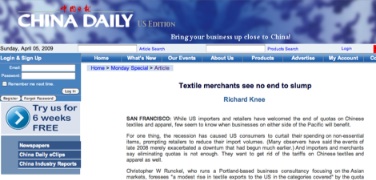
| Textile
Merchants See No End to Slump

While US importers and
retailers have welcomed the end of quotas on
Chinese textiles and apparel, few seem to know when businesses on
either side of the Pacific will benefit.
For one thing, the recession has caused US consumers to curtail their spending on non-essential items, prompting retailers to reduce their import volumes. (Many observers have said the events of late 2008 merely exacerbated a downturn that had begun much earlier.) And importers and merchants say eliminating quotas is not enough. They want to get rid of the tariffs on Chinese textiles and apparel as well. Christopher W Runckel, who runs a Portland-based business consultancy focusing on the Asian markets, foresees "a modest rise in textile exports to the US in the categories covered" by the quota erasures. But Laura E Jones, executive director of the United States Association of Importers of Textiles and Apparel (USA-ITA), is not so optimistic. "From what we can tell, there was no increase in Chinese textile and apparel imports [in 2008] and we don't foresee there will be one this year, either," said Jones, whose organization is based in Washington D.C., and represents industry interests. Containerships carrying Chinese products to the US have been sailing at 75 percent of capacity, Jones said. Additionally, a variety of developments has prompted many textile and apparel manufacturers to shift operations to other Asian countries, such as Bangladesh, Indonesia, Cambodia or Vietnam, she said. From January to November in 2008, China's textile and garment exports to the US hit $23.5 billion, a growth of 2.14 percent year-on-year, according to China's Customs. (It is important to note that value-based fluctuations do not necessarily reflect volume trends, since prices and currency-exchange rates change.) "When it is noted that these increases were achieved in a market where market demand sunk quickly in the final six months of the year, I believe the increases are noteworthy," said Runckel. "However, I see this very lack of demand that became most pronounced in the latter half of 2008 as continuing into 2009 and being the factor in holding down anything more than modest, single-digit increases in China's textile and garment exports to the US in 2009." Both Runckel and Jones said they doubted the lifting of quotas would prompt China to increase their purchases from the US. "In this environment, most companies are looking for every opportunity to defer buying decisions and to husband scarce financial resources," said Runckel. "Chinese companies are not different than their US brethren in this and I believe that they will thus only execute on the most needed buys in this strained environment, preferring to limit purchases for fear that demand will remain depressed." "I don't think that (the quotas' sunset) will prompt China to buy more from us," Jones said, noting that the US exports 70 to 80 percent of its cotton crop and China is the biggest customer. Though the quotas are gone, Chinese exporters and their US customers face other issues, tariffs being one. Jones said tariffs have been cut for all but two product types — textiles/apparel and footwear — and they average 17 to 18 percent for the former. The tariff on a silk blouse is 7 percent and on a man-made-fiber suit is 34 percent, she said. The tariff on shoes goes as high as 64 percent, the duty rate depending on materials and construction; by contrast, a pair of Ferragamo shoes from Italy has an 8 percent tariff, she said. Government raises textile tax rebate In a move aimed to help boost the country's struggling textile industry, China's State Council has raised the tax rebate rate for textile and garment exports from 14 percent to 15 percent. The increase will help reduce costs for exporters and support the textile industry. Under the plan, the government will also allocate funds for companies that produce textiles or fibers (or operate in the textile printing and dyeing sector) to upgrade technology and develop domestic brands. The textile sector is the backbone of China's economy and for years has enjoyed a competitive advantage in the international market. However, the industry started declining last year as the growth rate for China's textile and garment exports fell by 10.7 percentage points in 2008. The government has attributed the downturn to appreciation of the yuan, industry liquidity shortage, and an increase in production material costs. The government is also encouraging textile and garment makers to relocate from southeastern areas of China to central and western. Small and medium-sized textile plants are expected to receive financial support and insurance services from the government. The new plan implies the government will take a proactive attitude to enlarge domestic consumption, innovate new production, expand rural markets and promote the use of textile products in relevant industries, while expanding export destinations to stabilize the share in the international market. More of our useful articles:
|
